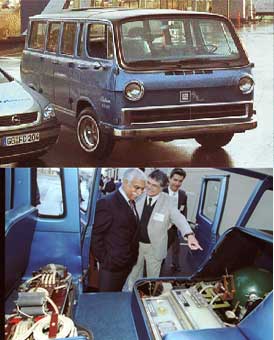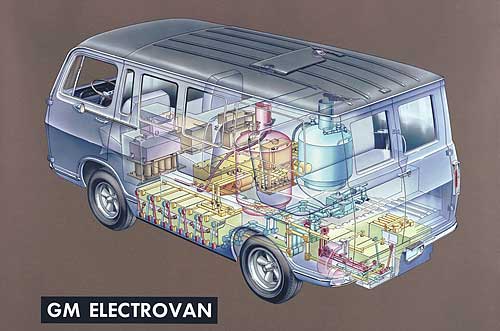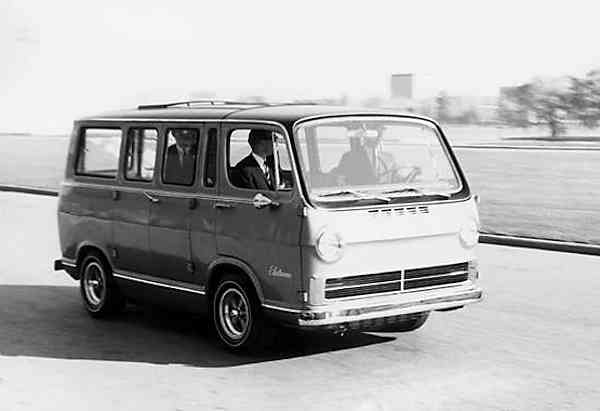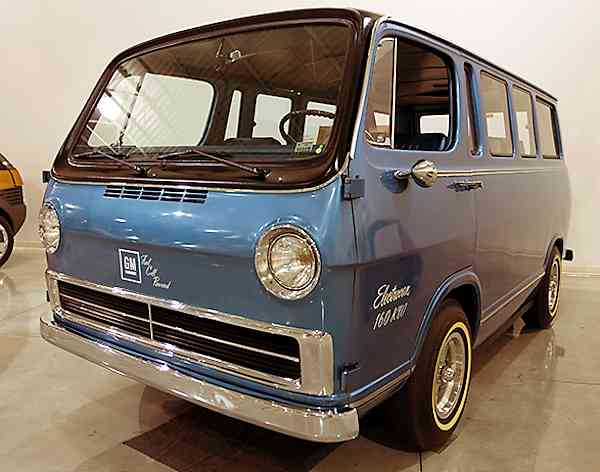1966 GM Electrovan
The 1966 GM Electrovan is credited with being the first hydrogen fuel cell car ever produced. Though fuel cells have been around since the early 1800’s, General Motors was the first to use a fuel cell to power the wheels of a vehicle.
 1966 GM Electrovan Shown to Journalists 1966 GM Electrovan Shown to Journalists |
The vehicle was a 1966 GMC Handivan on the outside. Its insides were converted into a science lab of new technology that appeared more like a whisky still of old. |
The GM Electrovan was the brainchild of Dr. Craig Marks who headed up most of General Motors’ advanced engineering projects. Marks, along with a staff of 250, developed the Electrovan for over 2 years before attaining a drivable vehicle.
NASA had previously used fuel cells to power onboard systems in their Gemini spacecraft. Those hydrogen fuel cells produced water as a byproduct, which the astronauts were then able to drink.
The GM Electrovan used a fuel cell produced by Union Carbide, which was fueled by both super-cooled liquid hydrogen and liquid oxygen. Today’s fuel cells use less pure oxygen that is native in the outside air. The Electrovan had one large tank for the hydrogen and one for the oxygen and contained 550-feet of piping throughout the rear of the vehicle, turning this 6-seat van into a 2-seater with barely enough room for 2 passengers.

General Motors Electrovan Illustration
The Union Carbide 5 kw fuel cell (rated at 1,000 hours of use) was able to propel the GM Electrovan for top speeds between 63 – 70 mph. The Electrovan also had a range of 120 miles, which was not too shabby for 1966. Because of safety concerns, the Electrovan was only used on company property, where it had several mishaps along the way.
From the outset, the idea was to use a Corvair as the first hydrogen fuel cell vehicle and call it Electrovair. But, GM soon discovered that a leak with the electrolyte used caused “brilliant fireworks”, plus it weighed 550 lbs. and needed to be housed in a larger vehicle. There was also the incident of the exploding hydrogen tank, which injured no one but sent pieces flying a quarter of a mile, which was of great concern and extra safety precautions needed to be taken to insure that no one working on the project was injured.

After the GM Electrovan was built, tested and shown off to journalists in 1966, the project was scrapped largely because it was cost-prohibitive. The platinum used in the fuel cell was enough to “buy a whole fleet of vans” and there was absolutely no supporting hydrogen infrastructure in place at that time.
General Motors tried to give the Electrovan to the Smithsonian Institution, but they declined the vehicle for reasons that are still not clear. For years, the Electrovan sat in cold storage in a warehouse in Pontiac, Michigan, avoiding the crusher on several occasions. Then it was transported to the General Motors Heritage Center near Detroit. Recently, the GM Electrovan was taken for display and shown off at the Petersen Automotive Museum in Los Angeles, California.

External Links
http://history.gmheritagecenter.com/wiki/index.php/1966_GM_Electrovan
PDF’s from External Website’s Pages that May No Longer Exist on the Internet
Images
Images are courtesy of the GM Heritage Center